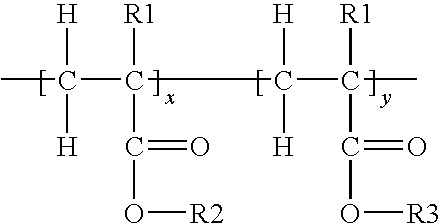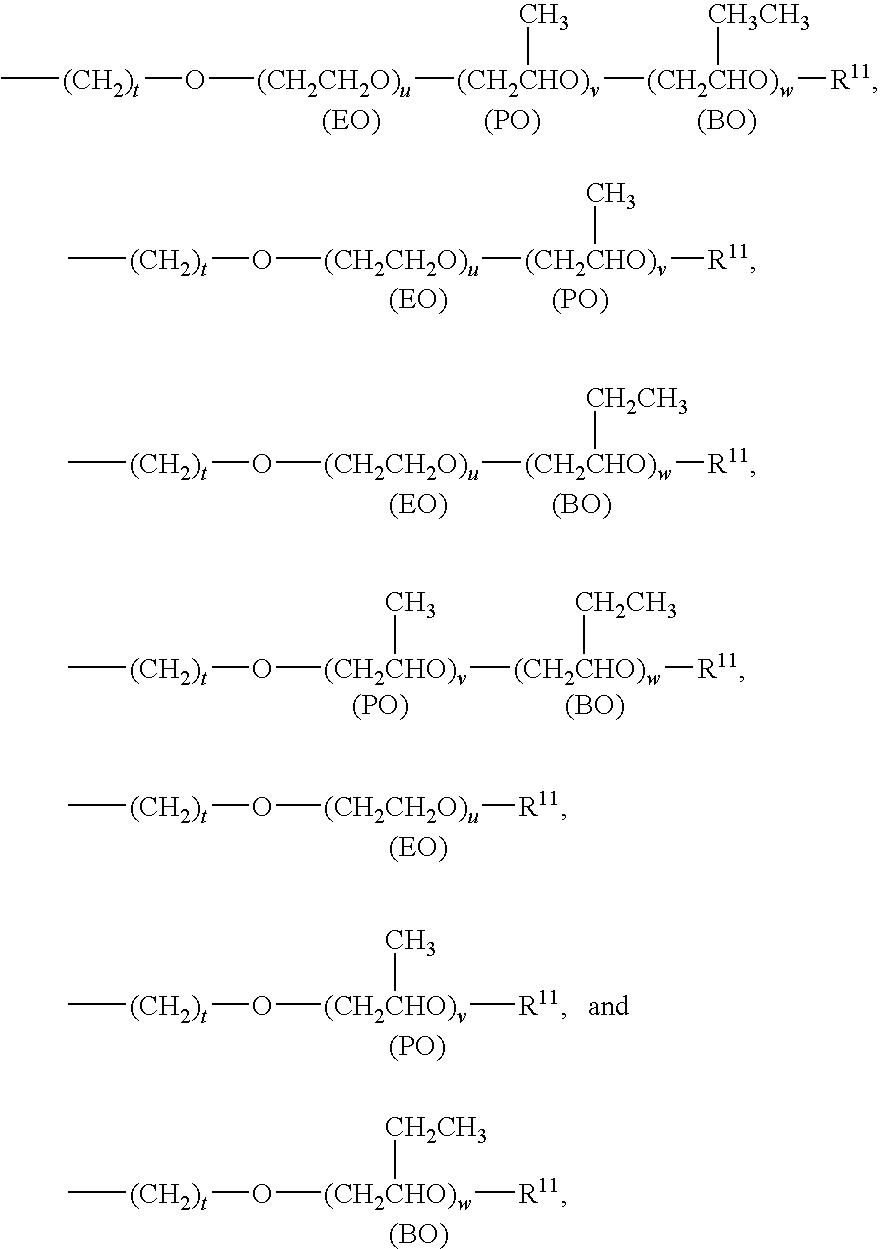Textile treatments using fluoropolymer-branched silicone polyethers
a technology of silicone polyethers and textiles, which is applied in the field of textile treatment by a fluoropolymerbranched silicone polyether composition, can solve the problems of harsh feel imparted by fluorocarbon treatments to the fabric surface, and the oil repellency of combined treatments is often much worse when compared to fluorocarbon treated fabrics
- Summary
- Abstract
- Description
- Claims
- Application Information
AI Technical Summary
Benefits of technology
Problems solved by technology
Method used
Image
Examples
example 1
Evaluation of BSPE's / fluoropolymer Fabric Treatment Based on Unidyne® TG-532 System (Noveon Inc.) on 100% Khaki Cotton Twill, 1% Silicone, 1% Fluoropolymer
[0062]Unidyne®-532 is a fluoroalkyl acrylate copolymer emulsion (aprox 19% actives, 25% solids) from Noveon Inc. Table 1 below shows that both BSPE 1 and BSPE 2 had and minimum impact or even improved the oil repellency in the Unidyne TG-532 system. In this fabric, which was treated with 1% Si, hand for BSPE 1 was perceived better than BSPE 2. As shown, branched spe's were compared with a commercially available amino-functional silicone, commonly used for fiber treatment.
[0063]
TABLE 1Oil Repellency(1) (HydrocarbonResistance Test-AATCC 118-1992)OilTreatment7654321Unidyne ® TG-532BB+A−AAAAOnlyUnidyne ® TG-532 &CBA−AAAABSPE IUnidyne ® TG-532 &BA−AA−AAABSPE IIUnidyne ® TG-532 &CCC+B−B+A−AAminofunctionalSilicone(1)Ratings:A - Pass, B - Borderline pass, C & D fail
[0064]
Hand Rating(1)TreatmentUnidyne ®Unidyne ®Unidyne ®Amino-Unidyne ®TG-...
example 2
Evaluation of BSPE's / fluoropolymer Fabric Treatment Based on Unidyne® TG-532 System (Noveon Inc.) on 65 / 35 Polycotton Woven, 1% Silicone, 1% Fluoropolymer Solids
[0065]On polycotton both Branched spe's had a minimum impact on the oil repellency provided by the fluoropolymer while providing very good softness to the treated fabric. Softness for branched spe's was similar and perceived as mid-range among all the silicones evaluated (evaluation included conventional amino-functional silicones as well). Both branched spe's showed no impact on water repellency for polycotton. Results are shown in the tables below:
[0066]
Oil Repellency(1) (HydrocarbonResistance Test-AATCC 118-1992)OilTreatment7654321Unidyne ® TG-532B−B−AAAAAOnlyUnidyne ® TG-532 &B−B−B+A−AAABSPE IUnidyne ® TG-532 &B−BBA−AAABSPE IIUnidyne ® TG-532 &CC+C+B−B−A−AAminofunctionalSilicone(1)Ratings: A - Pass, B - Borderline pass, C & D fail
[0067]
Water Repellency, Spray Rating (AATCC-22)TreatmentUnidyne ®Unidyne ®Unidyne ®Unidyne ®...
example 3
Evaluation of BSPE's / fluoropolymer Fabric Treatment Based on Unidyne® TG-532 System (Noveon Inc.) on 100% Cotton Knit, 0.7% Silicone, 1.4% FC
[0069]The branched silicone polyethers were evaluated on a 100% cotton knit, using 0.7% silicone and 1.4% fluorocarbon, following the procedures of example 1. The results are summarized in Table 3 below.
[0070]
TABLE 3Oil Repellency(1) (HydrocarbonResistance Test-AATCC 118-1992)OilTreatment7654321Unidyne ® TG-532B+B+A−AAAAOnlyUnidyne ® TG-532 &B+B+A−AAAABSPE I(1)Ratings: A - Pass, B - Borderline pass, C & D fail
[0071]
Hand Rating(1)TreatmentUnidyne ®Unidyne ®TG-532 OnlyTG-532 & BSPERating14(1)Relative Hand Rating obtained from a panel of expert evaluators: 1 is the least soft, 5 is the softest.
PUM
| Property | Measurement | Unit |
|---|---|---|
| pressure | aaaaa | aaaaa |
| hydrophilicity | aaaaa | aaaaa |
| softness | aaaaa | aaaaa |
Abstract
Description
Claims
Application Information
 Login to View More
Login to View More - R&D
- Intellectual Property
- Life Sciences
- Materials
- Tech Scout
- Unparalleled Data Quality
- Higher Quality Content
- 60% Fewer Hallucinations
Browse by: Latest US Patents, China's latest patents, Technical Efficacy Thesaurus, Application Domain, Technology Topic, Popular Technical Reports.
© 2025 PatSnap. All rights reserved.Legal|Privacy policy|Modern Slavery Act Transparency Statement|Sitemap|About US| Contact US: help@patsnap.com



